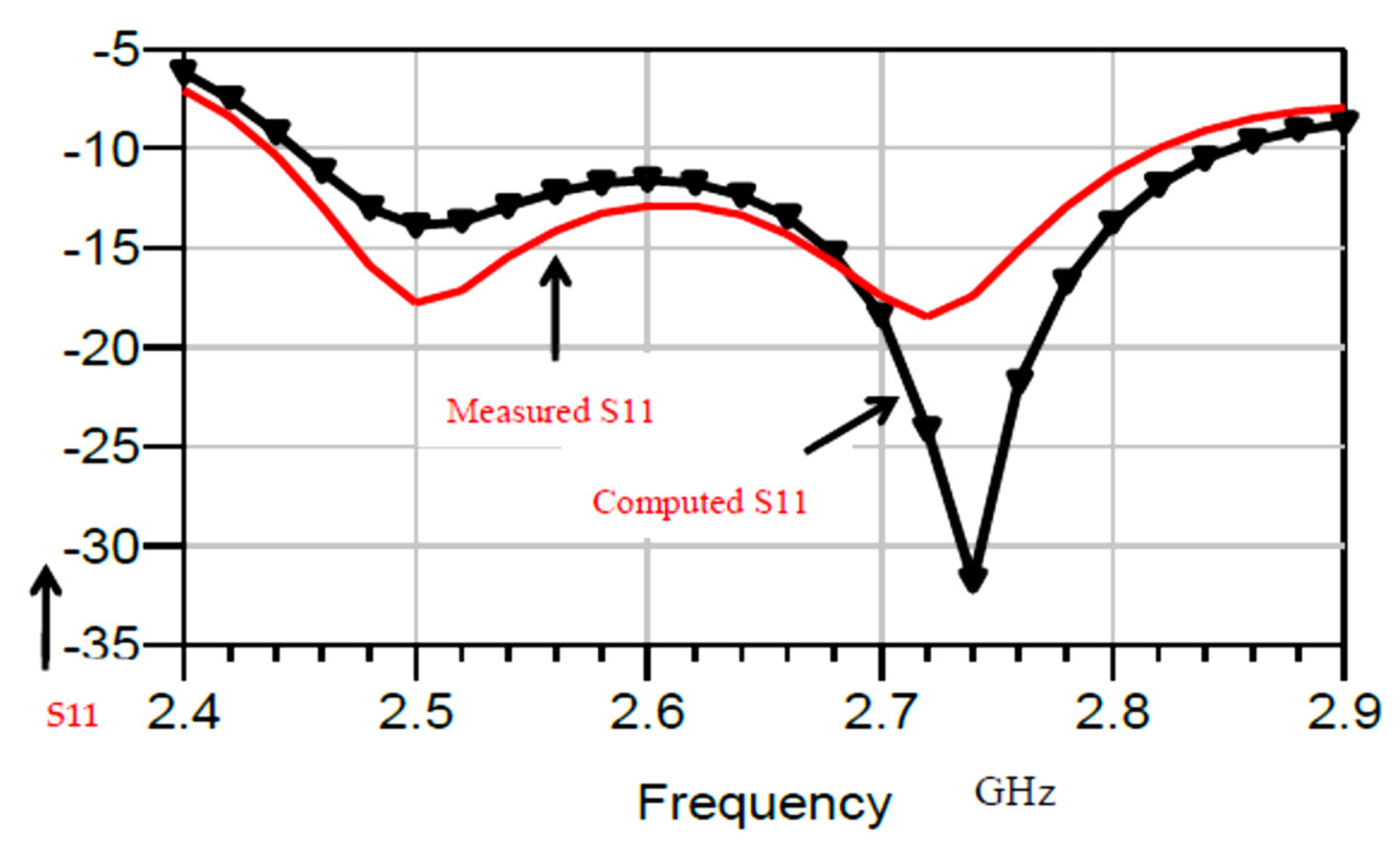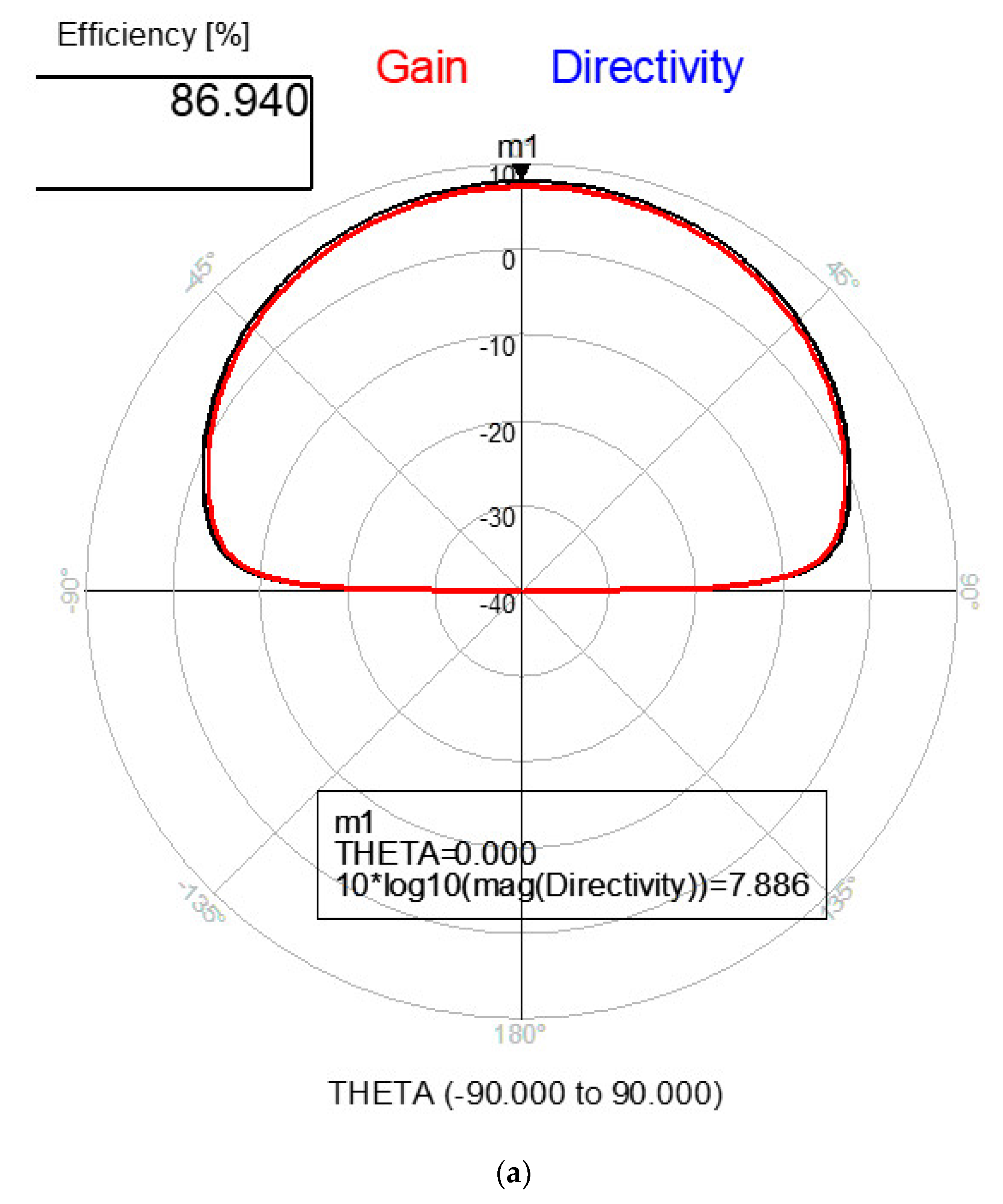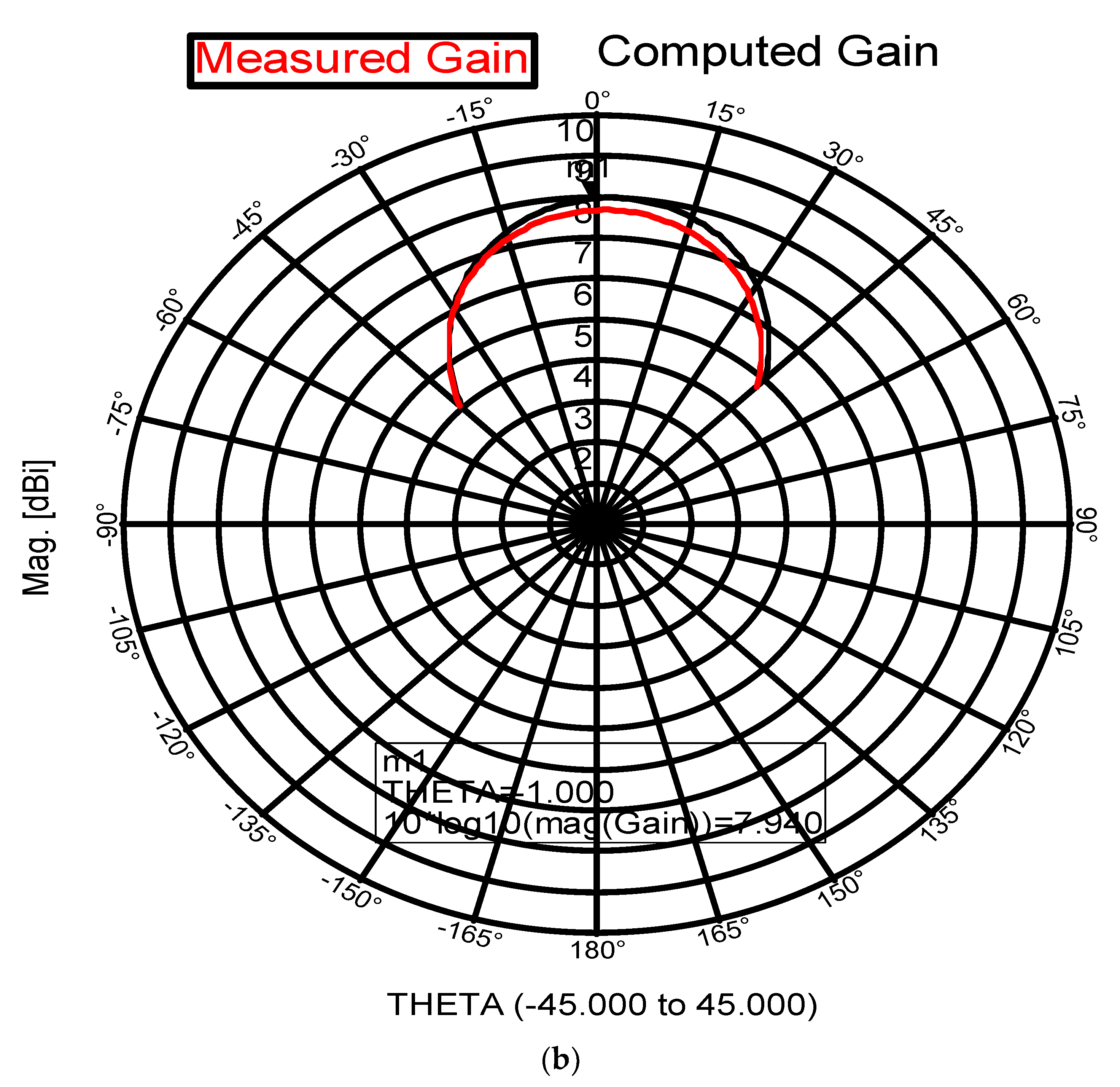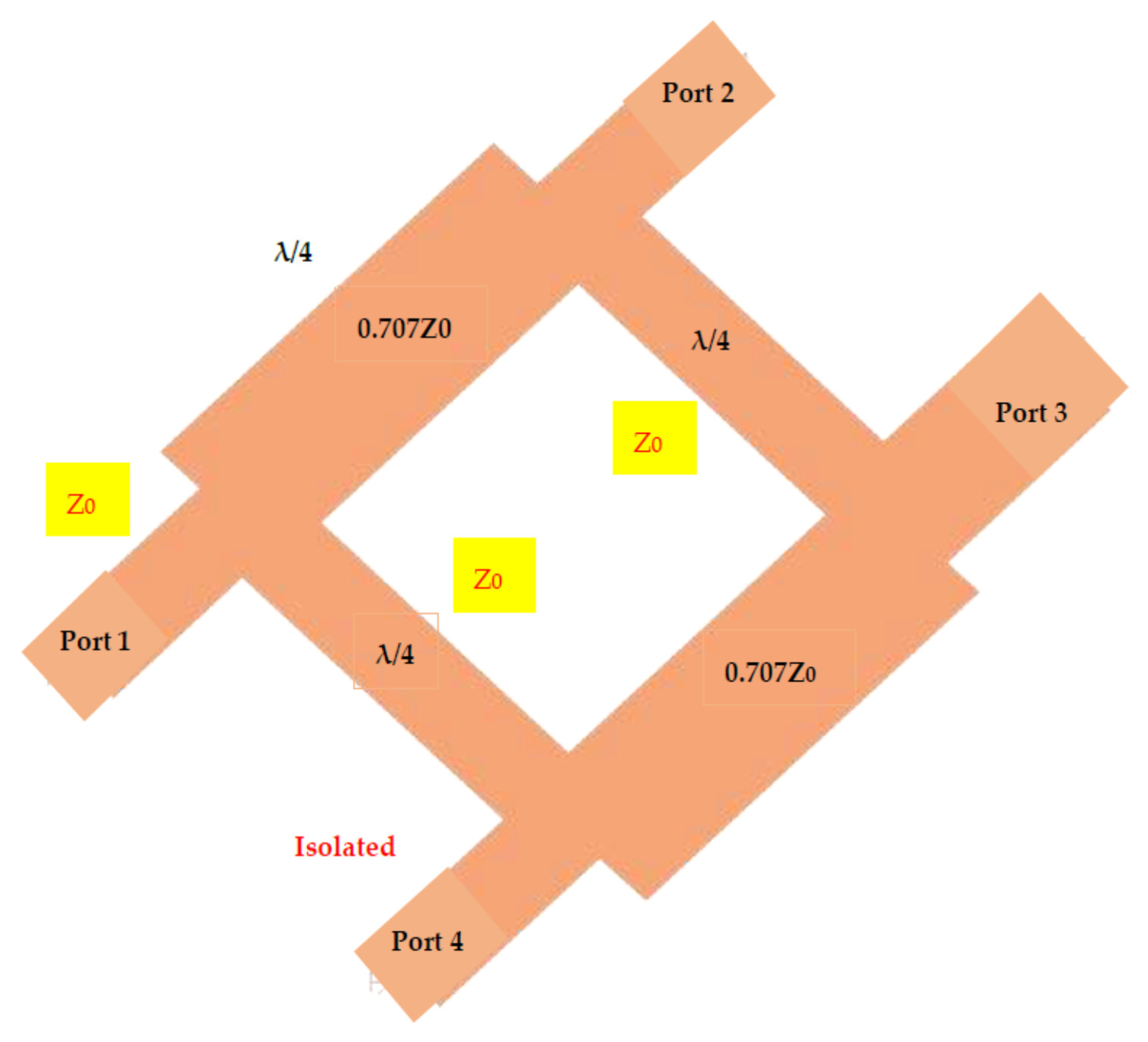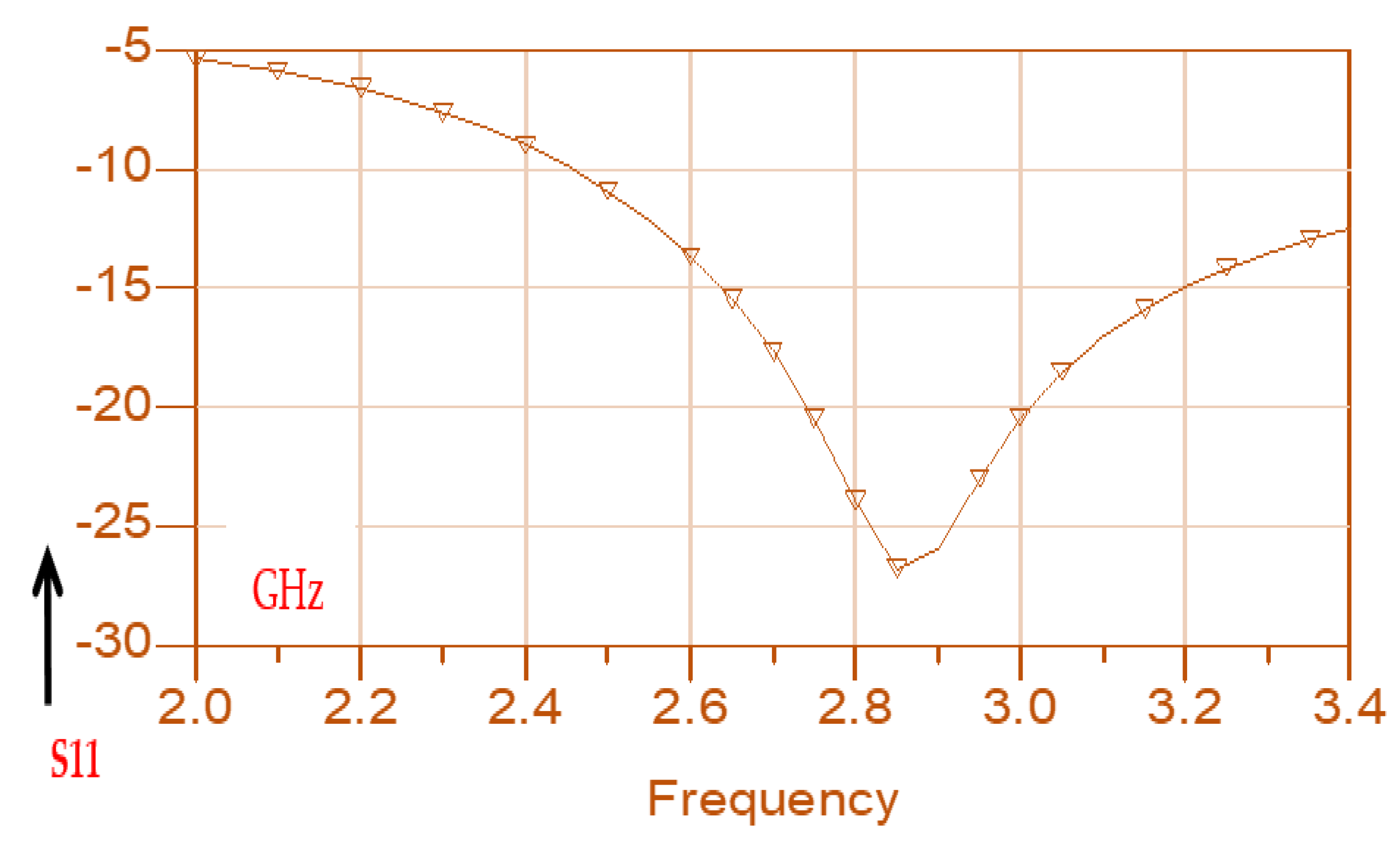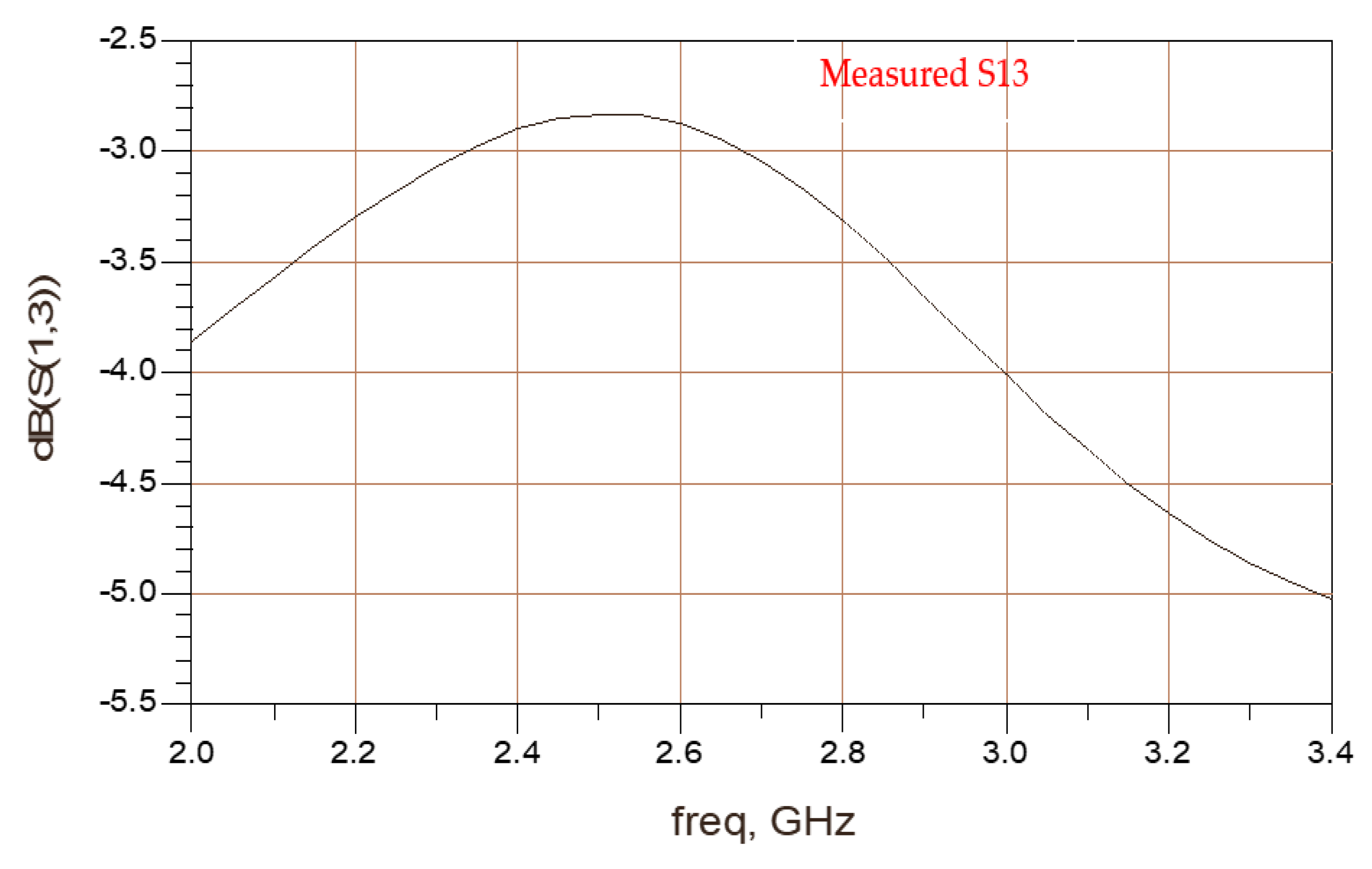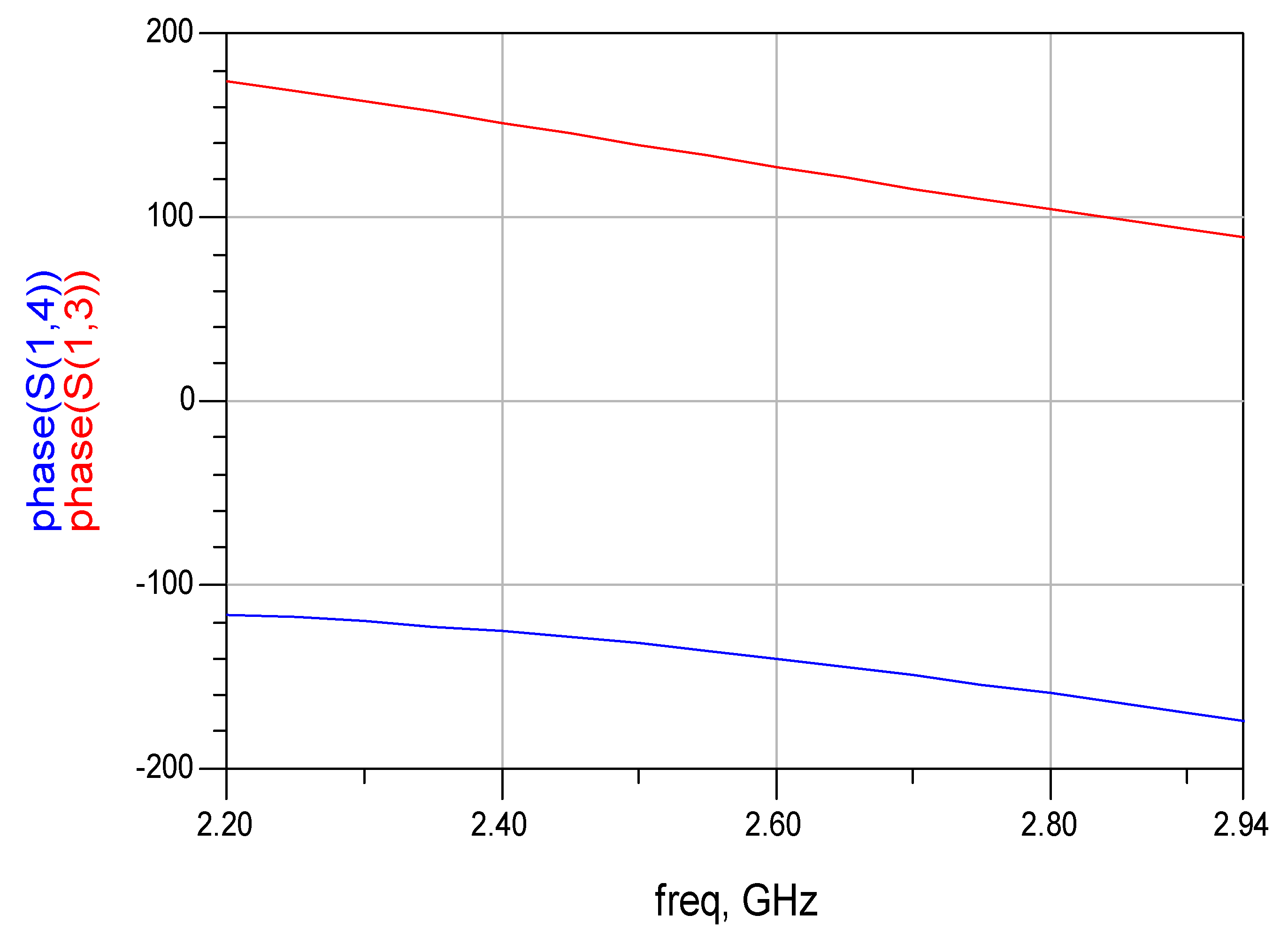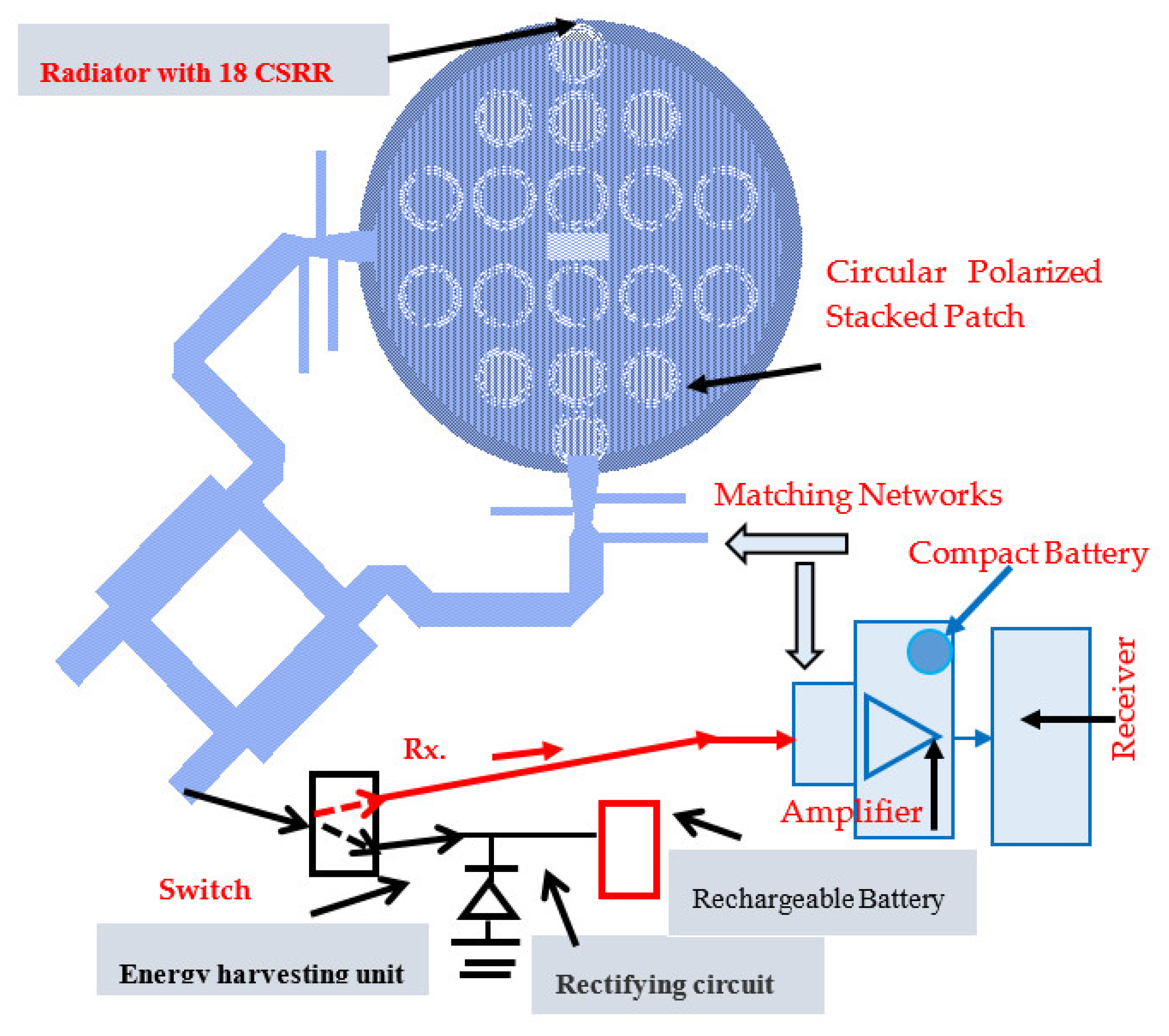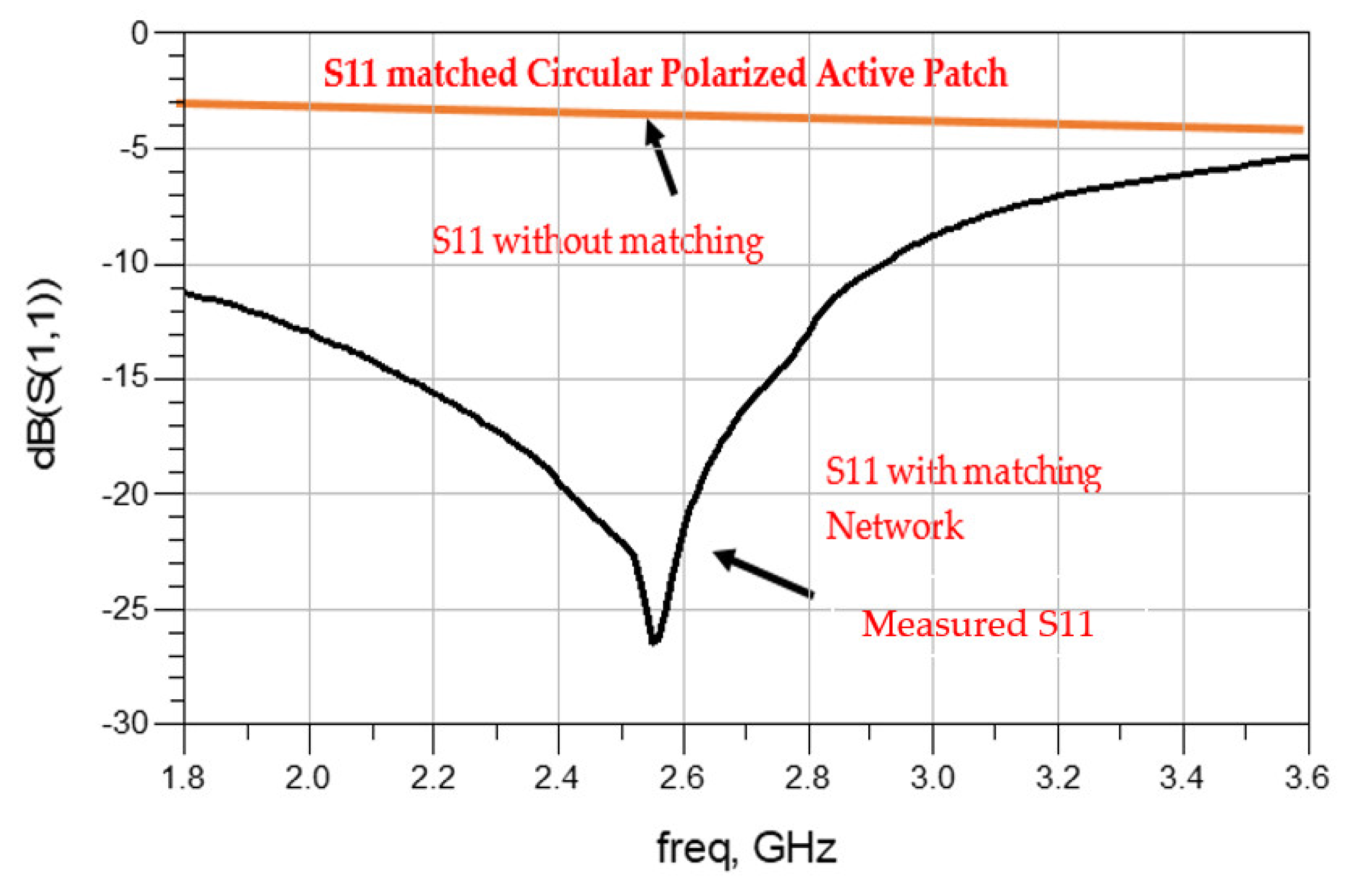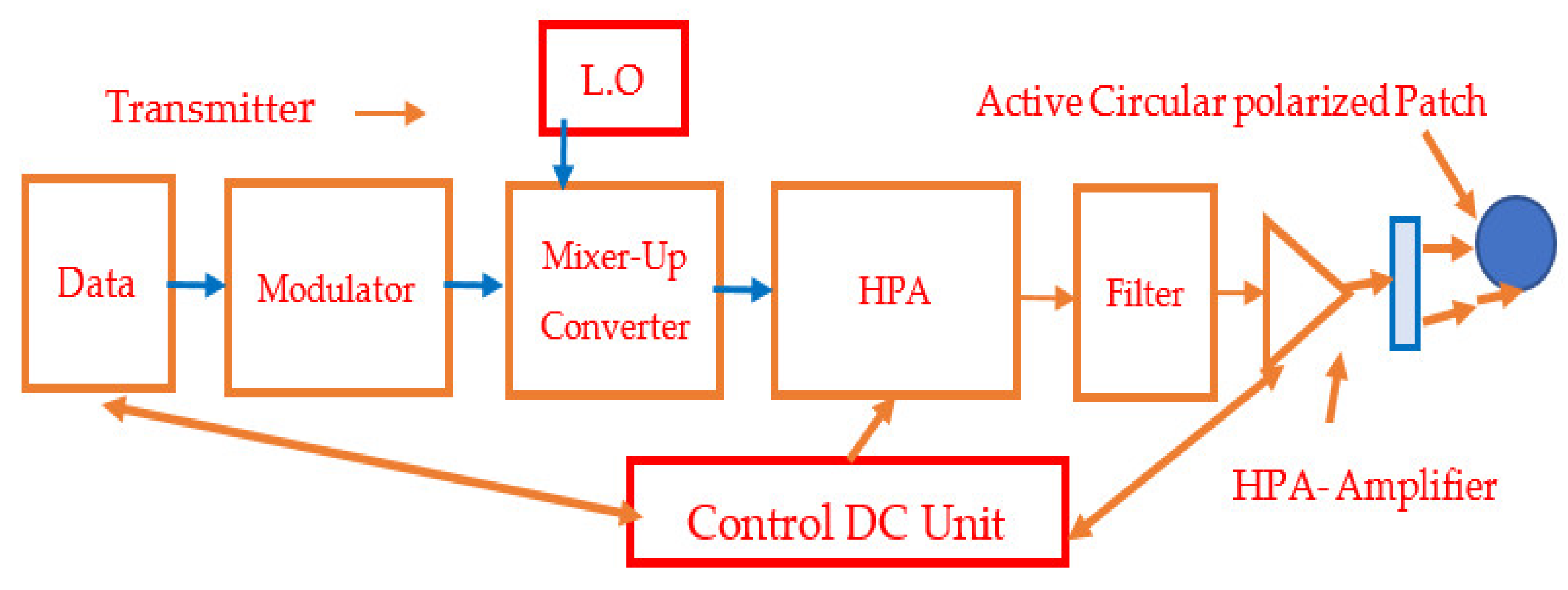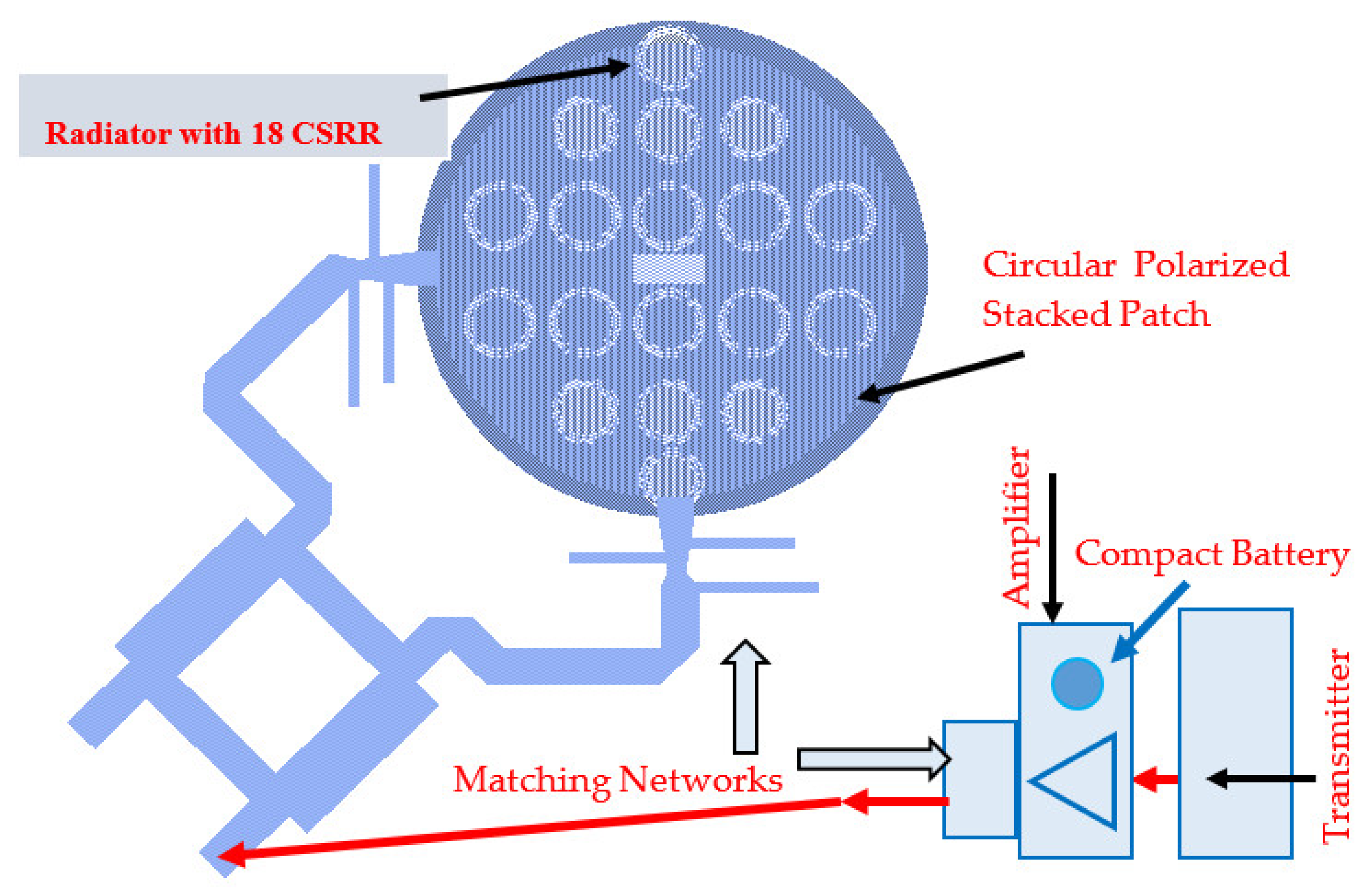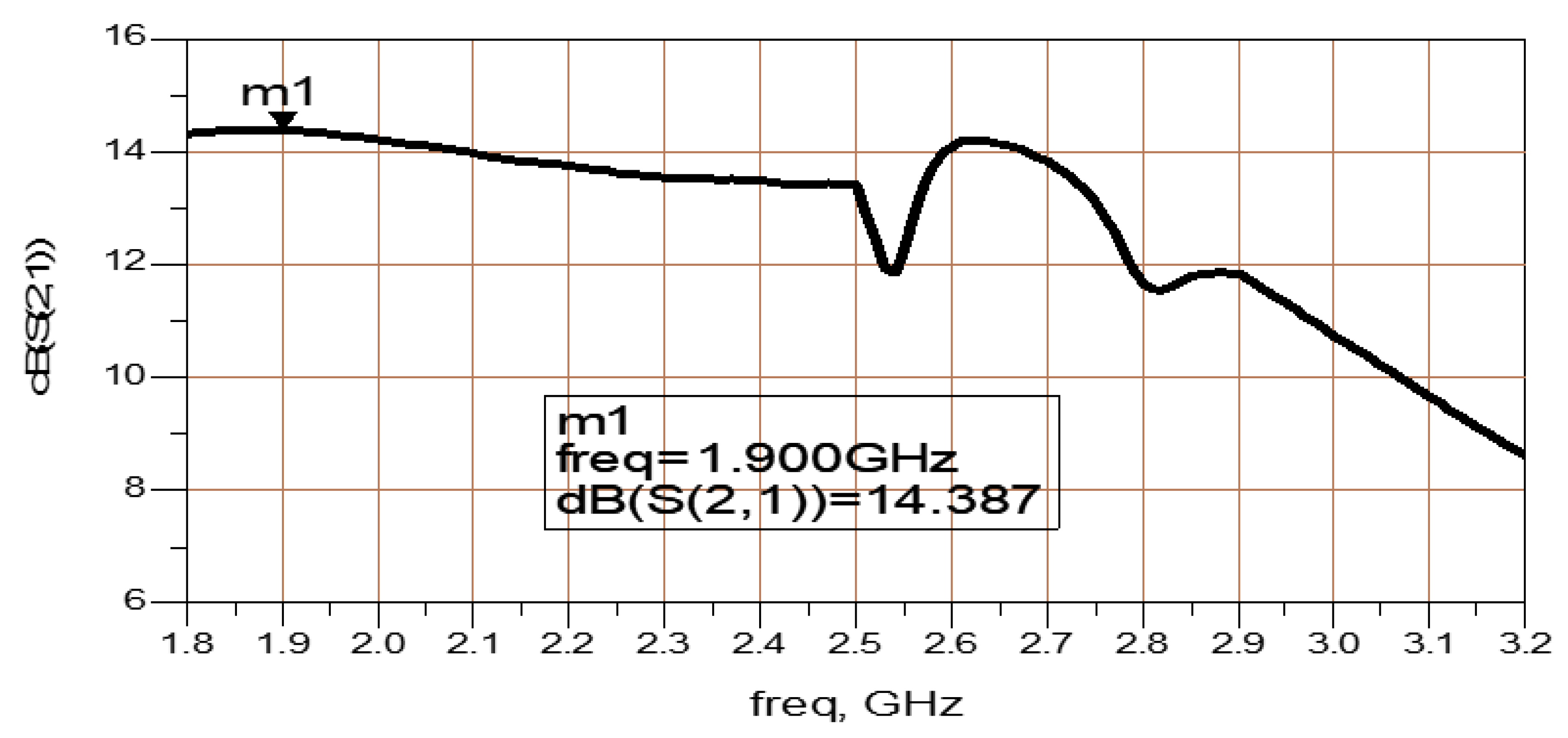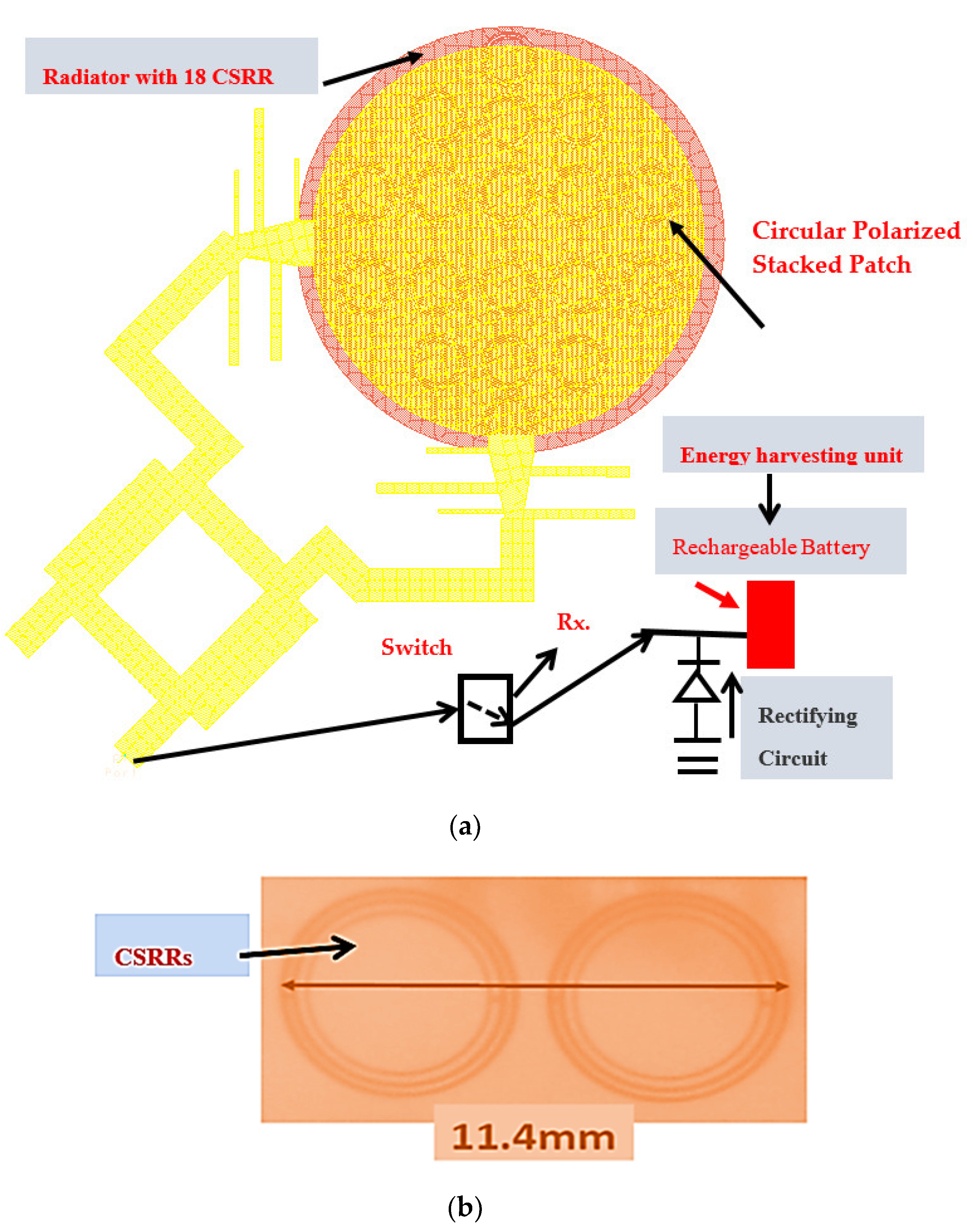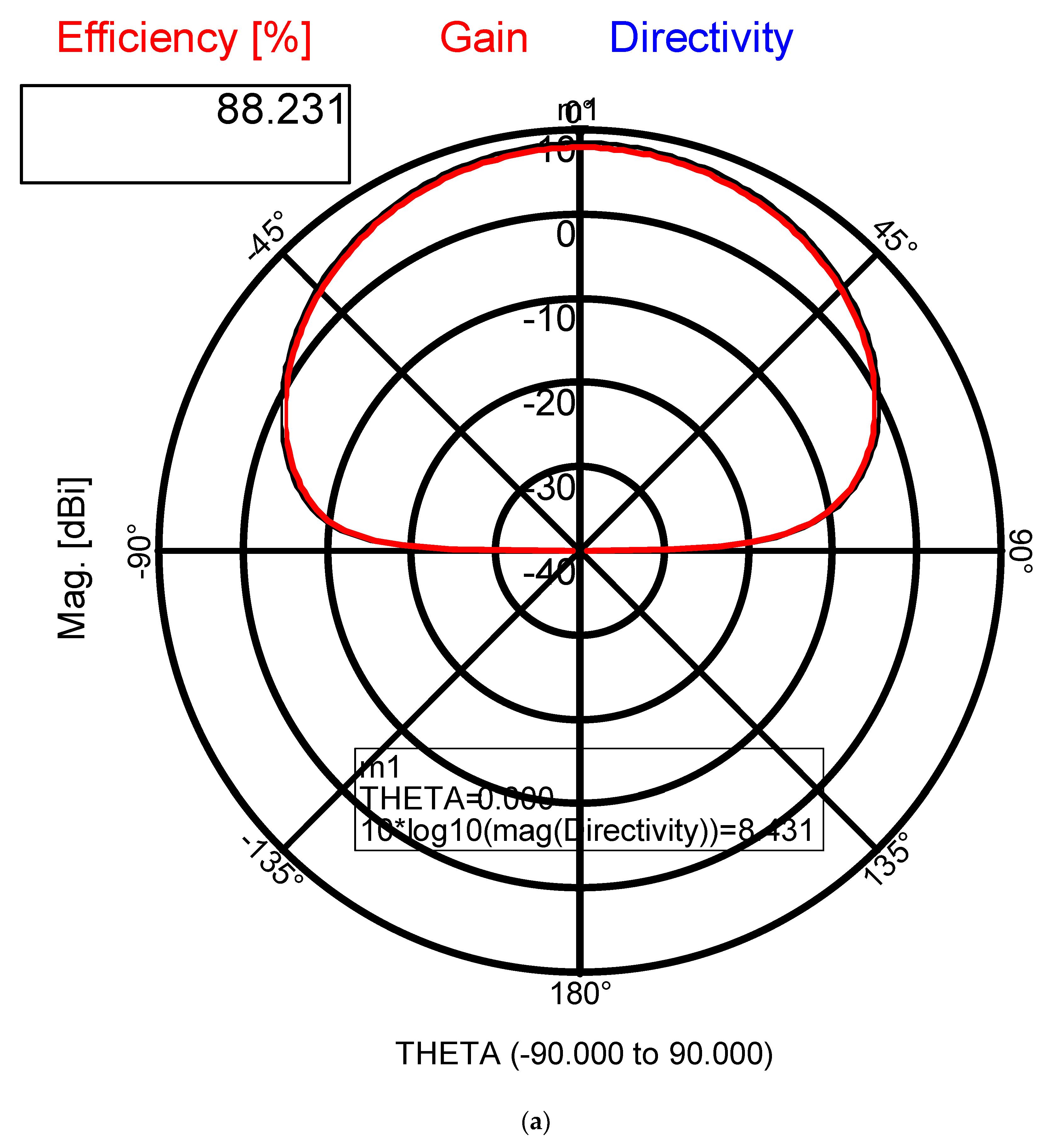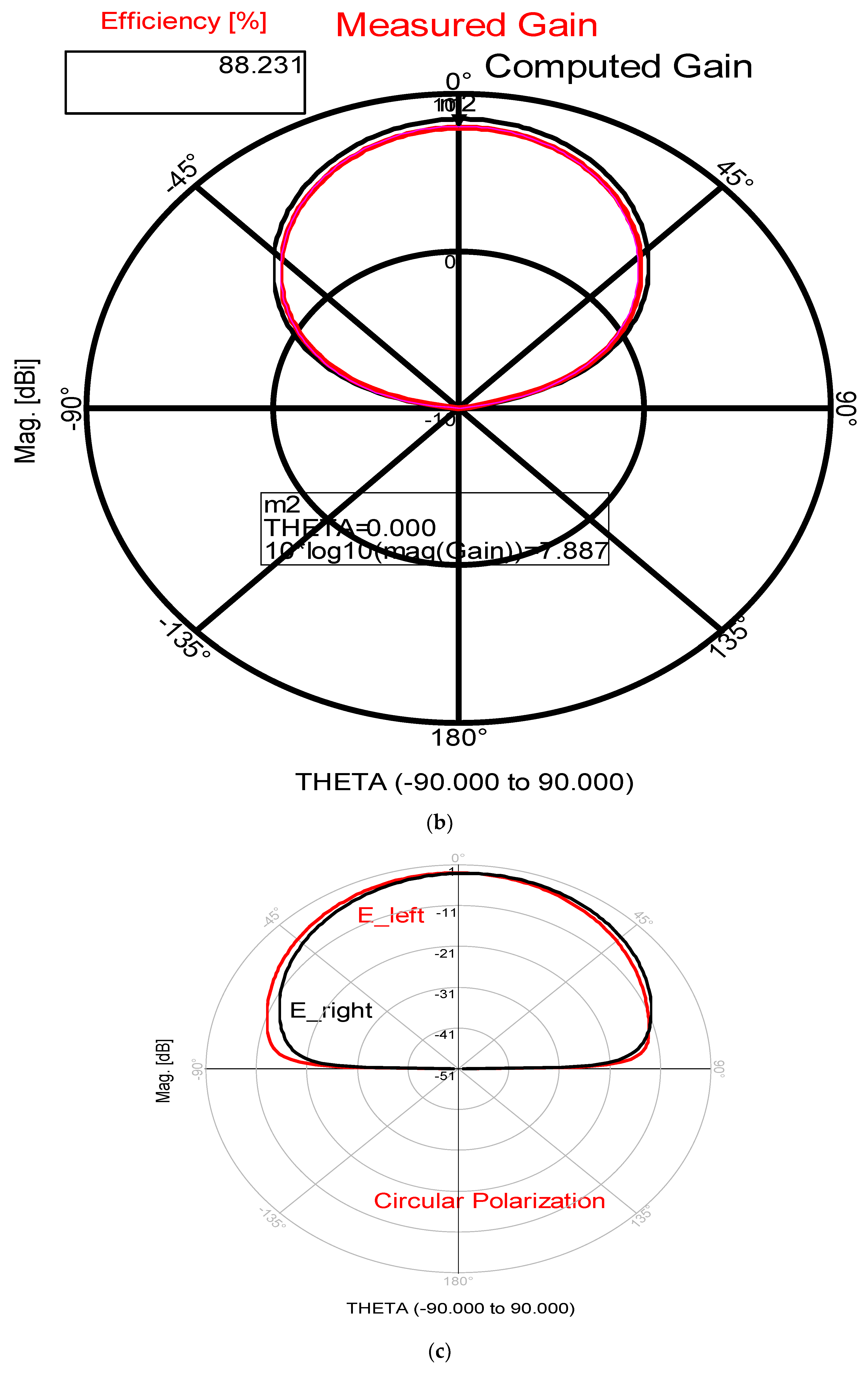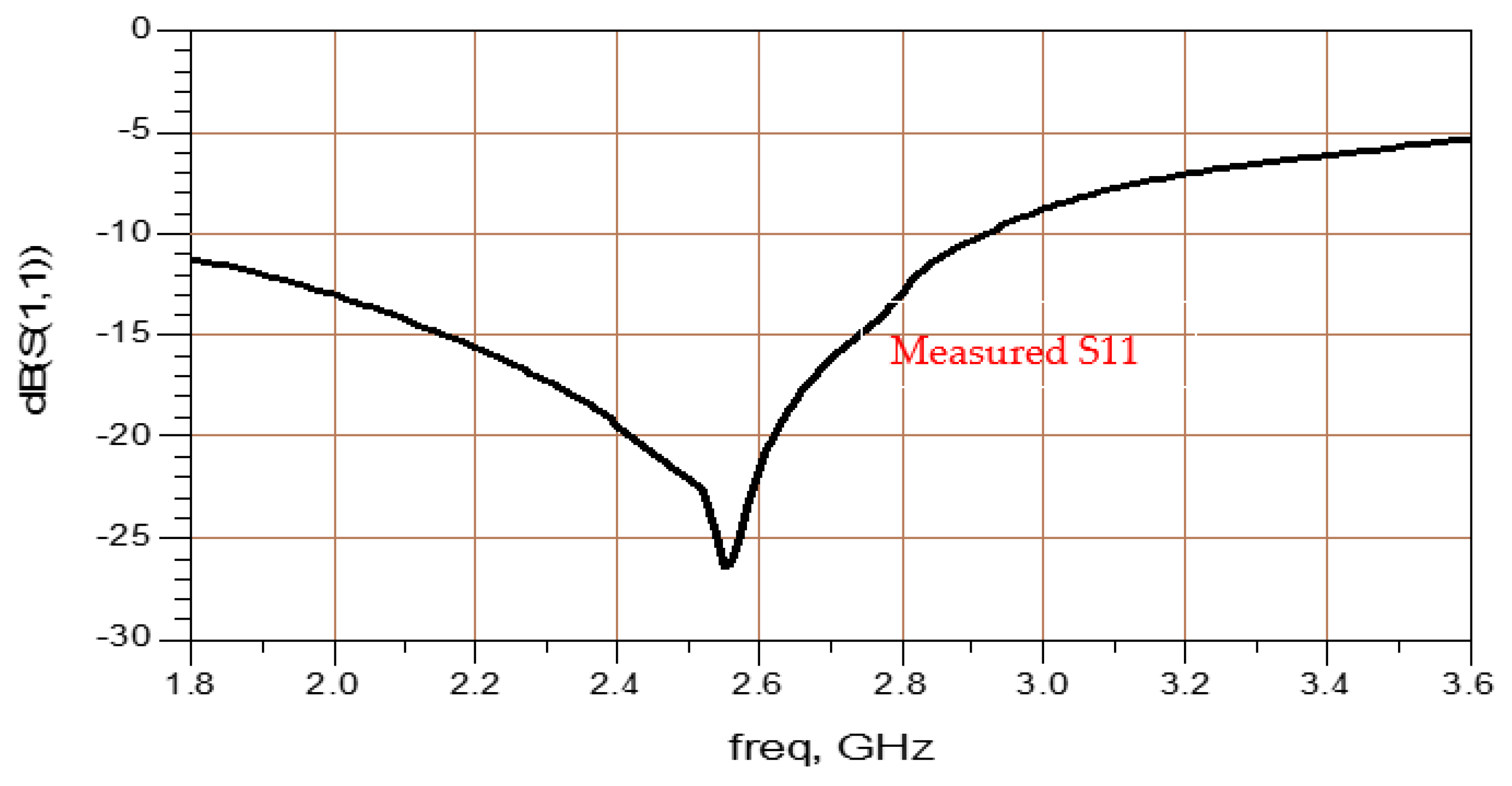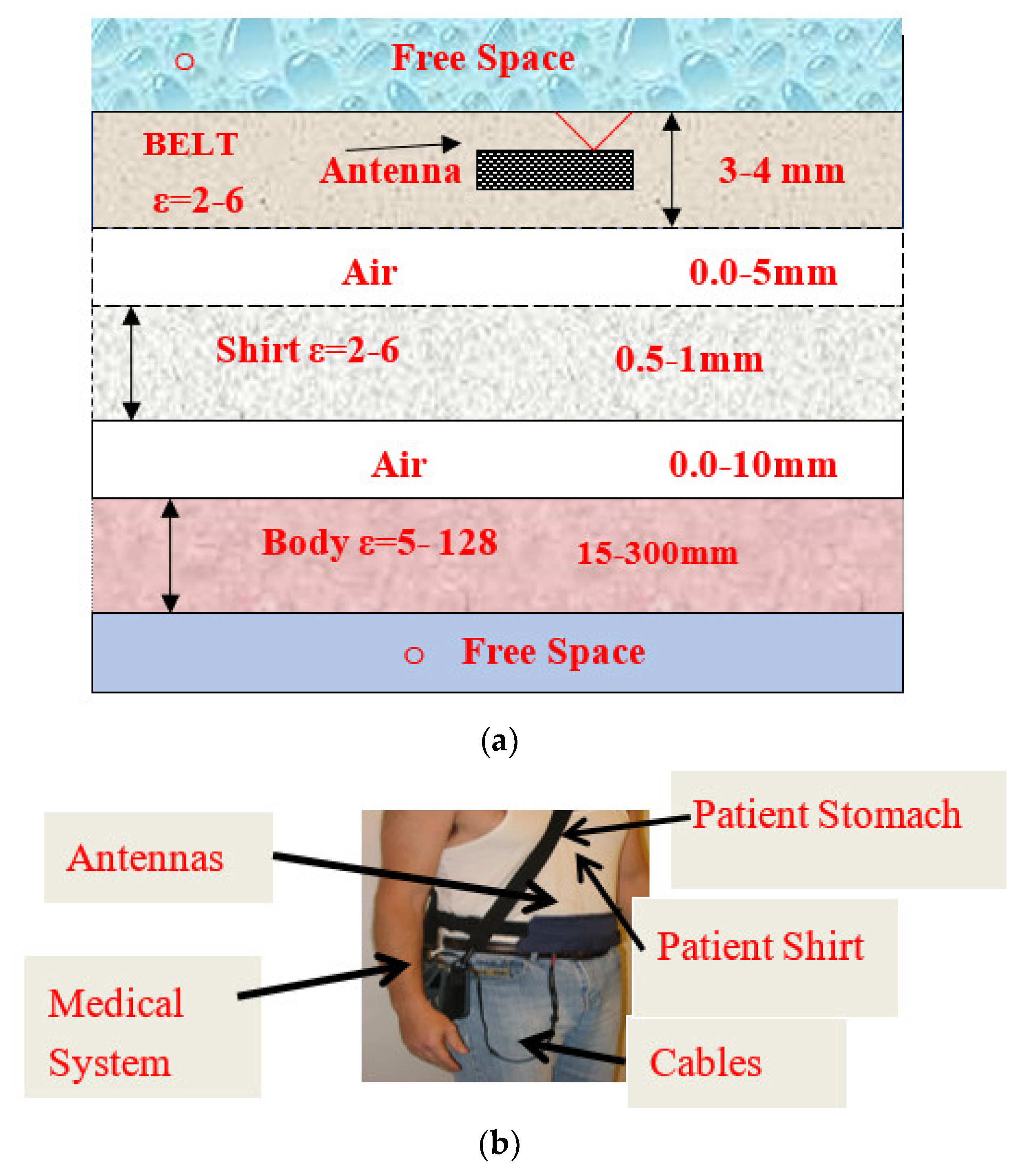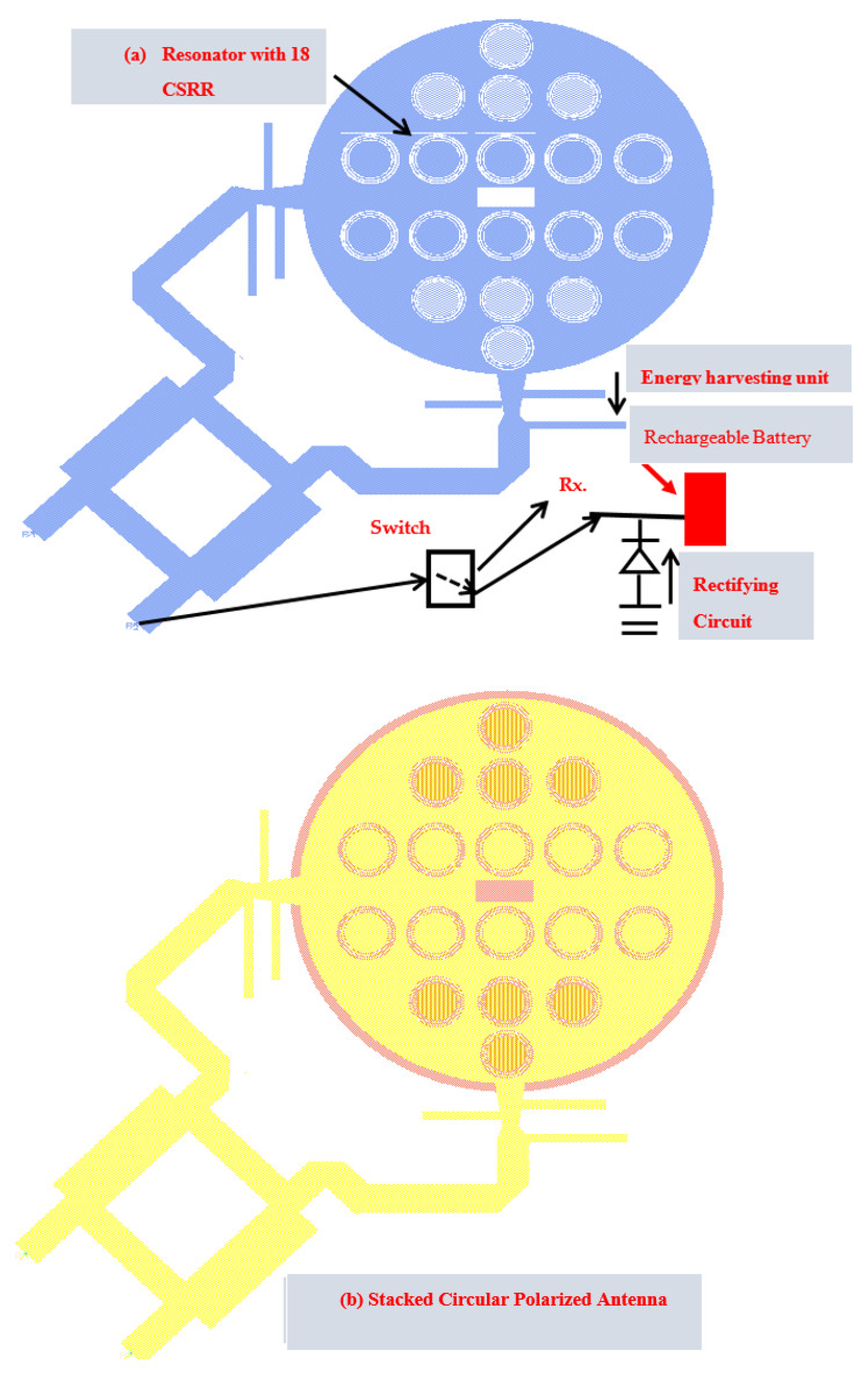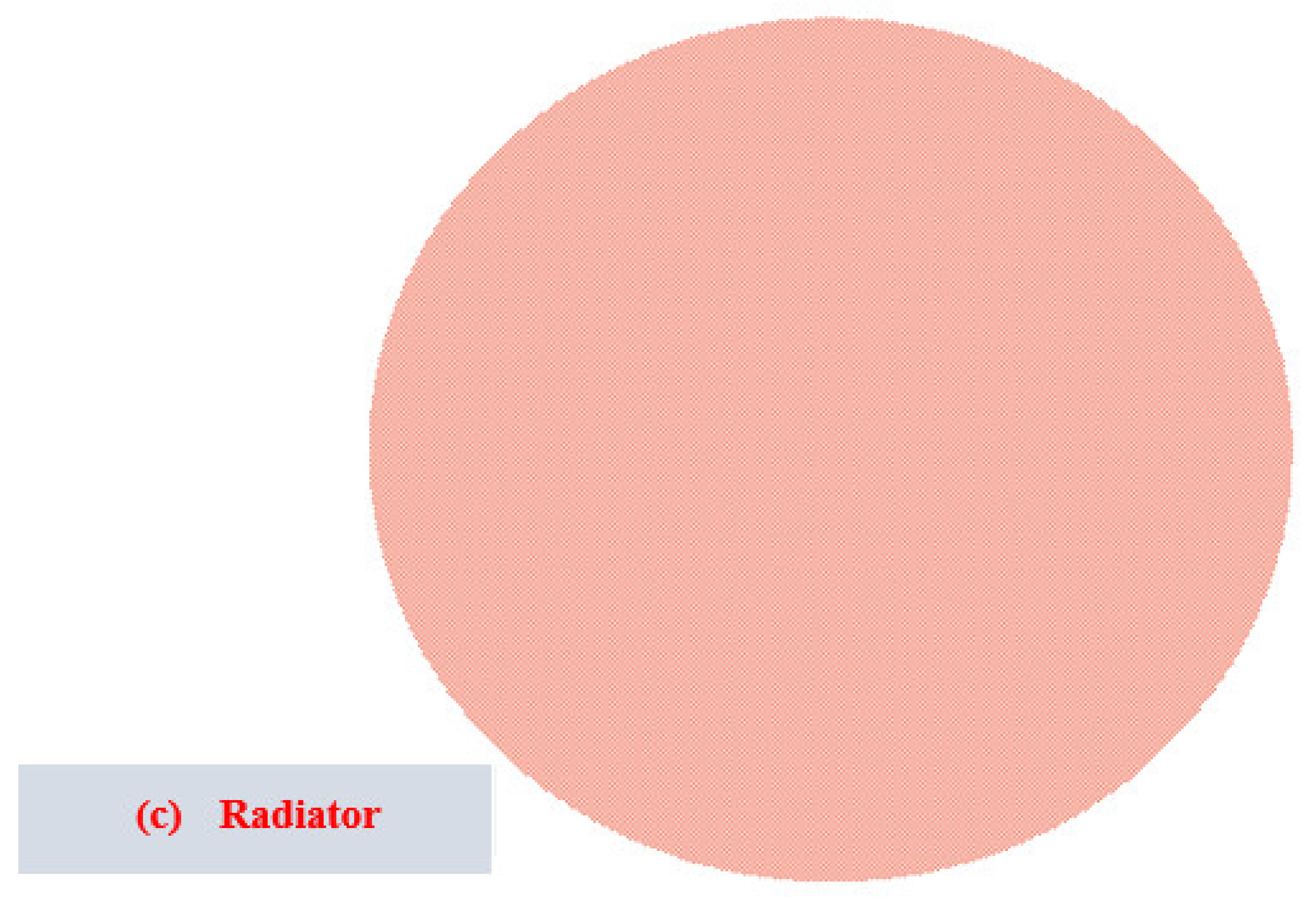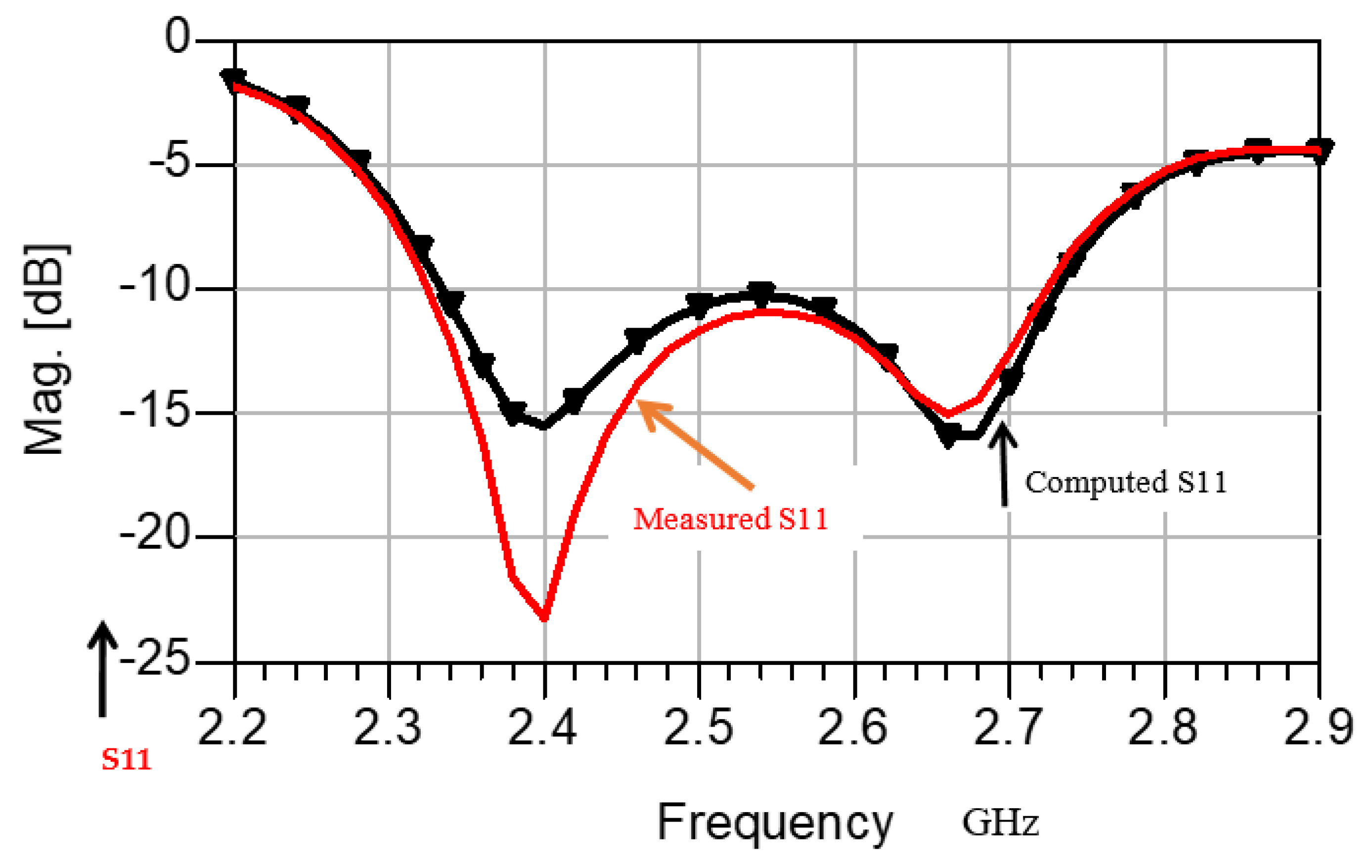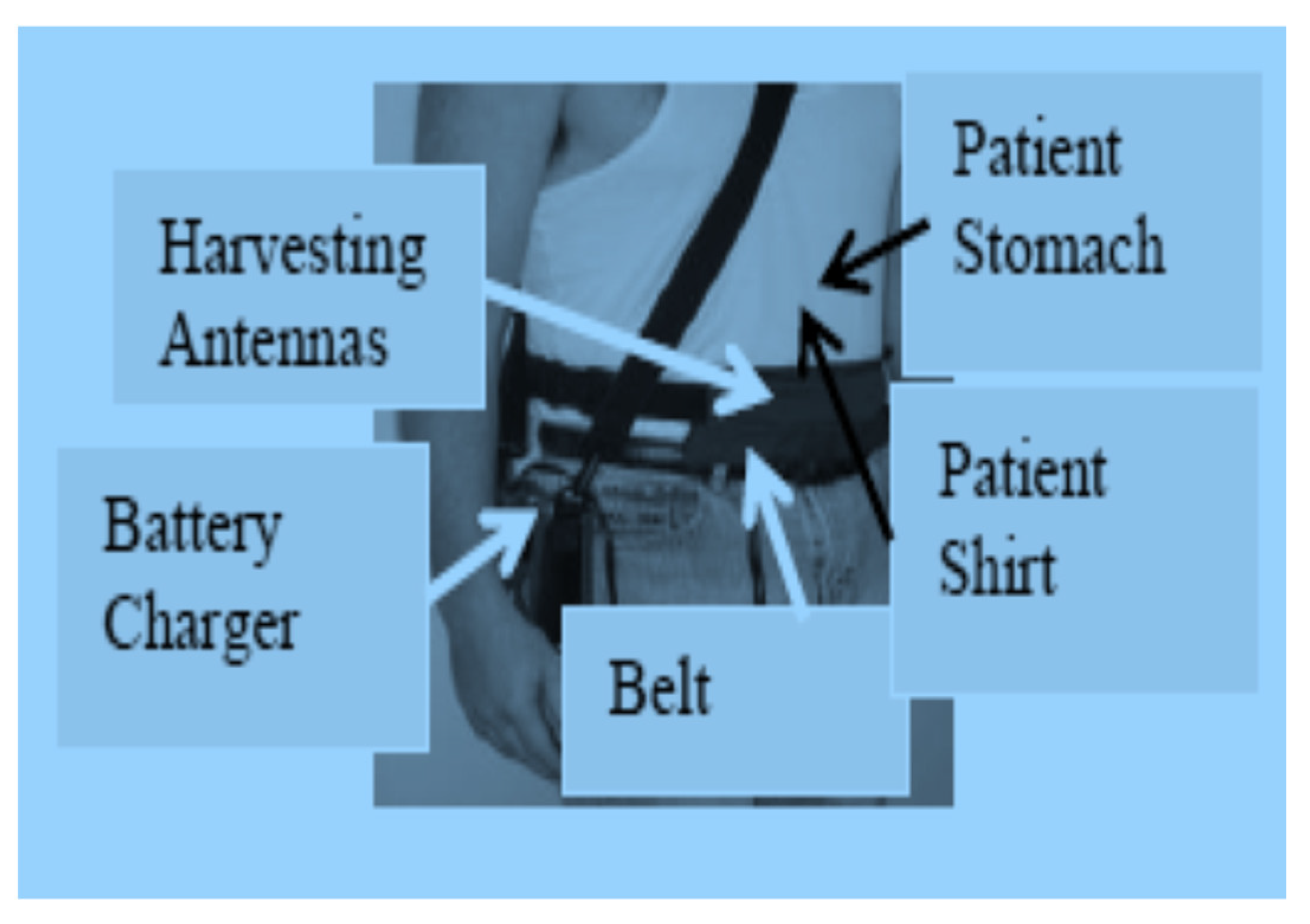Figure 1.
(a) Single CSRR (b) Circular polarized sensor and harvester. (c) The radiator.
Figure 1.
(a) Single CSRR (b) Circular polarized sensor and harvester. (c) The radiator.
Figure 2.
Computed and measured S11 of the metamaterial circular polarized antenna.
Figure 2.
Computed and measured S11 of the metamaterial circular polarized antenna.
Figure 3.
(a) Radiation pattern of the circular polarized, at 2.6 GHz. (b) Comparison of computed and measured.
Figure 3.
(a) Radiation pattern of the circular polarized, at 2.6 GHz. (b) Comparison of computed and measured.
Figure 4.
Layout of the −3 dB branch line coupler.
Figure 4.
Layout of the −3 dB branch line coupler.
Figure 5.
The branch line coupler reflection coefficient, S11.
Figure 5.
The branch line coupler reflection coefficient, S11.
Figure 6.
The branch line coupler measured S13 transfer parameter.
Figure 6.
The branch line coupler measured S13 transfer parameter.
Figure 7.
The branch line coupler phase difference between S13 and S14 parameters.
Figure 7.
The branch line coupler phase difference between S13 and S14 parameters.
Figure 8.
Block diagram of a receiver with wearable active circular polarized antenna.
Figure 8.
Block diagram of a receiver with wearable active circular polarized antenna.
Figure 9.
Circular polarized wearable active receiving Sensor with energy harvesting unit.
Figure 9.
Circular polarized wearable active receiving Sensor with energy harvesting unit.
Figure 10.
Measured S11 of the Circular polarized active receiving antenna.
Figure 10.
Measured S11 of the Circular polarized active receiving antenna.
Figure 11.
Matching network of the circular polarized active receiving sensor.
Figure 11.
Matching network of the circular polarized active receiving sensor.
Figure 12.
Gain, S21, of the Circular Polarized Active Receiving Sensor.
Figure 12.
Gain, S21, of the Circular Polarized Active Receiving Sensor.
Figure 13.
Transmitting channel block diagram with a wearable active transmitting sensor.
Figure 13.
Transmitting channel block diagram with a wearable active transmitting sensor.
Figure 14.
Active Circular Transmitting Patch antenna for Internet of Things (IoT) and 5G Applications.
Figure 14.
Active Circular Transmitting Patch antenna for Internet of Things (IoT) and 5G Applications.
Figure 15.
Optimized Active Transmitting antenna: (a) Matching circuit; (b) S11 Smith chart diagram.
Figure 15.
Optimized Active Transmitting antenna: (a) Matching circuit; (b) S11 Smith chart diagram.
Figure 16.
Gain, S21, of the Active Transmitting Circular Polarized Antenna.
Figure 16.
Gain, S21, of the Active Transmitting Circular Polarized Antenna.
Figure 17.
Wideband Metamaterial Circular Polarized Sensor (a) Antenna; (b) CSRRs Photo.
Figure 17.
Wideband Metamaterial Circular Polarized Sensor (a) Antenna; (b) CSRRs Photo.
Figure 18.
S11 and S22 parameters of the circular polarized Patch Antenna with CSRRs.
Figure 18.
S11 and S22 parameters of the circular polarized Patch Antenna with CSRRs.
Figure 19.
Polar radiation pattern of the Circular Polarized patch with CSRR. (a) Radiation pattern; (b) Computed and measured gain. (c) The circularity of the circular polarized sensor.
Figure 19.
Polar radiation pattern of the Circular Polarized patch with CSRR. (a) Radiation pattern; (b) Computed and measured gain. (c) The circularity of the circular polarized sensor.
Figure 20.
Metamaterial Circular Polarized Transceiver for IoT and medical applications.
Figure 20.
Metamaterial Circular Polarized Transceiver for IoT and medical applications.
Figure 21.
Measured S11 parameters of the circular polarized transmitting channel.
Figure 21.
Measured S11 parameters of the circular polarized transmitting channel.
Figure 22.
S21 parameters of the circular polarized transmitting channel.
Figure 22.
S21 parameters of the circular polarized transmitting channel.
Figure 23.
S21 parameters of the circular polarized receiving channel.
Figure 23.
S21 parameters of the circular polarized receiving channel.
Figure 24.
(a) Model of human body tissues and antenna (b). A patient wearing a wearable healthcare sensor.
Figure 24.
(a) Model of human body tissues and antenna (b). A patient wearing a wearable healthcare sensor.
Figure 25.
Metamaterial Circular Polarized Patch with a harvesting unit, for IoT and medical applications. (a) Resonator with CSRRs (b) Stacked circular polarized patch (c) Radiating patch.
Figure 25.
Metamaterial Circular Polarized Patch with a harvesting unit, for IoT and medical applications. (a) Resonator with CSRRs (b) Stacked circular polarized patch (c) Radiating patch.
Figure 26.
Simulated and measured S11 of the wearable circular Polarized Antenna with CSRR.
Figure 26.
Simulated and measured S11 of the wearable circular Polarized Antenna with CSRR.
Figure 27.
(a) Photo of the lab module of the Active Circular Stacked antenna (b) A photo of the lab module of the Active Circular Polarized patch (c) Layout of the Active Antenna modules analysis.
Figure 27.
(a) Photo of the lab module of the Active Circular Stacked antenna (b) A photo of the lab module of the Active Circular Polarized patch (c) Layout of the Active Antenna modules analysis.
Figure 28.
Smart City IoT, and healthcare monitoring systems with wearable sensors and WBAN Networks.
Figure 28.
Smart City IoT, and healthcare monitoring systems with wearable sensors and WBAN Networks.
Figure 29.
Voltage rectifier, half wave, with a shunt capacitor.
Figure 29.
Voltage rectifier, half wave, with a shunt capacitor.
Figure 30.
Diode Bridge rectifier, full wave, with a shunt capacitor.
Figure 30.
Diode Bridge rectifier, full wave, with a shunt capacitor.
Figure 31.
Wearable RF Medical Sensors with Energy Harvesting unit for IoT, 5G, and Healthcare Applications.
Figure 31.
Wearable RF Medical Sensors with Energy Harvesting unit for IoT, 5G, and Healthcare Applications.
Table 1.
Small Antennas Gain and efficiency Comparison, 1970–2021.
Table 1.
Small Antennas Gain and efficiency Comparison, 1970–2021.
| Antennas Type | 1970–1980 [1,2] | 1981–1995 [1,2] | 1996–2010 [3] | 2011–2021 [2] |
|---|
| Gain dB | Efficiency % | Gain dB | Effic. % | Gain dB | Effic. % | Gain dB | Effic. % |
|---|
| Printed dipole | 2 | 30 | 2.5 | 50 | 3 | 70 | 4 | 80 |
| Patches | 2.5 | 50 | 3 | 70 | 3.5 | 70 | 4 | 80 |
| Stacked patches | - | - | 6 | 80 | 7 | 85 | 7.5 | 85 |
| Metamaterial Antennas | - | - | - | - | 4 | 50 | 8.5 | 90 |
| Metamaterial with strips | - | - | - | - | - | - | 5.5–7.5 | 90 |
| Fractal Antennas | - | - | 2 | 50 | 4.5 | 70 | 5 | 80 |
Table 2.
Small Antennas Bandwidth Comparison, 1970–2021.
Table 2.
Small Antennas Bandwidth Comparison, 1970–2021.
| Antennas Type | Printed Dipole | Patches | Stacked Patches | Metamaterial Antennas | Metamaterial with Strips | Fractal Antennas |
|---|
| Antenna bandwidth %, 1970–1980 [1,2] | 5 | 2 | - | - | - | - |
| Antenna bandwidth %, 1981–1995 [1,2] | 5 | 3 | 10 | - | - | 2 |
| Antenna bandwidth %, 1996–2010 [3] | 5 | 5 | 12 | 10 | - | 5 |
| Antenna bandwidth %, 2011–2021 [2] | 5 | 5 | 15 | 50 | 50 | 10 |
Table 3.
Branch line coupler design.
Table 3.
Branch line coupler design.
| Impedance | W mm | εe | L (λ/4) mm |
|---|
| Z0 = 50 Ω | 3 | 3.4 | 14.8 |
| Z0 = 35.4 Ω | 5.1 | 3.6 | 14.4 |
Table 4.
Specification of the S band Low Noise Amplifier.
Table 4.
Specification of the S band Low Noise Amplifier.
| Parameter | Specification | Remarks |
|---|
| Frequency | 0.4–3 GHz | - |
| Gain at 1.9 GHz | 18 dB | Vds = 3 V |
| N.F at 1.9 GHz | 0.5 dB | - |
| P1dB at 1.9 GHz | 19.0 dBm | - |
| OIP3 at 1.9 GHz | 33.5 dBm | - |
| Max Input power | 17 dBm | - |
| Vgs | 0.50 V | - |
| Vds | 3 V | Ids = 60 mA |
| Supply voltage | ±5 V | - |
| Package | Surface Mount | - |
| Operating Temperature | −40 °C–80 °C | - |
Table 5.
LNA noise parameters at S band.
Table 5.
LNA noise parameters at S band.
| LNA Noise Data |
|---|
| F-GHz | N. FMIN | N11X | N11Y | n |
|---|
| 1.40 | 0.24 | 0.350 | 76.50 | 0.036 |
| 1.90 | 0.30 | 0.370 | 100.93 | 0.03 |
| 2.00 | 0.32 | 0.372 | 106.01 | 0.03 |
| 2.40 | 0.40 | 0.380 | 125.79 | 0.03 |
| 3.00 | 0.49 | 0.400 | 153.93 | 0.036 |
| 3.90 | 0.65 | 0.430 | −167.30 | 0.06 |
| 4.50 | 0.72 | 0.460 | −145.55 | 0.09 |
Table 6.
Comparison of simulated and measured results of circular microstrip patches [
15].
Table 6.
Comparison of simulated and measured results of circular microstrip patches [
15].
| Antenna | Frequency (GHz) | Bandwidth % | VSWR | Computed Gain dBi | Measured Gain dBi |
|---|
| Circular patch [15] | 2.62 | 2 | 2:1 | 4.4 | 4.1 |
| Circular patch with CSRR [15] | 2.52–2.68 | 8 | 2:1 | 7–7.6 | 7–7.9 |
| Circular polarized patch with CSRR | 2.5–2.9 | 20 | 2:1 | 7.5–8.3 | 7.2–8 |
| Active Circular Rx. Patch [15] | 2.4–2.8 | 25 | 2:1 | 12–14 | 11.5–13.8 |
| Stacked circular patch with CSRR [15] | 2.6–2.8 | 8 | 2:1 | 7–8.4 | 7.2–8.5 |
| Active Stacked Circular Patch [15] | 2.4–2.8 | 25 | 2:1 | 12–14 | 12–15 |
| Active Circular Polarized Patch | 2.4–2.8 | 40 | 2:1 | 10–14 | 10–15 |
Table 7.
Specification of the High-power S band surface mount amplifier (HPA).
Table 7.
Specification of the High-power S band surface mount amplifier (HPA).
| Parameter | Specification | Remarks |
|---|
| Frequency range | 1–4 GHz | - |
| Gain at 2.5 GHz | 15 dB | Vds = 5 V |
| N.F at 2 GHz | 5.5 dB | - |
| P1dB at 2 GHz | 18.0 dBm | Ids = 85 mA |
| OIP3 at 2 GHz | 29 dBm | - |
| Input power | 10 dBm | Maximum |
| Vgs | 0.50 V | - |
| Vds | 4–5 V | - |
| Ids | 60–85 mA | - |
| Bias voltage | ±5 V | - |
| Temperature range | −40 °C–85 °C | Operating |
Table 8.
S band High-power amplifier S parameters.
Table 8.
S band High-power amplifier S parameters.
| F-GHz | S11 dB | S11° | S21 dB | S21° | S12 dB | S12° | S22 dB | S22° |
|---|
| 1.56 | −12.3 | 137.6 | 17.5 | 134.9 | 67.8 | −11.2 | −18.9 | 92.4 |
| 1.6 | −12.8 | 134.3 | 18.3 | 123.3 | −44.2 | −93.4 | −18.9 | 113.7 |
| 1.8 | −14.3 | 101.2 | 17.9 | 83 | −43 | −86.3 | −22 | 69.5 |
| 2 | −16.5 | 61.8 | 17.3 | 43.5 | −40.4 | 94.6 | −27 | 6.42 |
| 2.16 | −18.5 | 22.1 | 16.8 | 12.9 | −38 | −105.5 | −27.8 | −70.2 |
| 2.4 | −19.4 | −53.9 | 15.7 | −31.8 | −36 | −128 | −22.2 | −147.2 |
| 2.56 | −17.7 | 99.7 | 15 | −60 | −34.6 | −145.6 | −19.3 | −179.4 |
| 2.7 | −15.7 | 131 | 14.3 | −84.3 | −33.8 | −160.3 | −17.5 | 158.1 |
| 2.86 | −13.7 | 159 | 13.5 | −111.1 | −33 | −177.7 | −16 | 134.7 |
| 3 | −12.2 | 179.1 | 12.7 | −134.1 | −32.4 | 167.4 | 15.2 | 116.3 |
| 3.18 | −10.9 | 158.1 | 11.5 | −164.9 | −29.4 | 133.8 | −16.1 | 176.4 |
| 3.4 | −9.3 | 129.33 | 10.3 | 156.5 | −28.9 | 107.7 | −16.05 | 146.9 |
| 3.6 | −8.5 | 109.5 | 9.4 | 128.2 | −28.4 | 87.9 | −15.9 | 128.5 |
Table 9.
Electrical parameters of human body tissues [
16,
17].
Table 9.
Electrical parameters of human body tissues [
16,
17].
| Tissue | Parameter | 440 MHz | 600 MHz | 1 GHz | 1.25 GHz |
|---|
| Fat tissues | σ | 0.047 | 0.05 | 0.054 | 0.06 |
| ε | 5.00 | 5.00 | 4.72 | 4.55 |
| Stomach tissues | σ | 0.71 | 0.75 | 0.96 | 0.98 |
| ε | 42.7 | 41.40 | 39.66 | 39.00 |
| Blood | σ | 1.76 | 1.78 | 1.91 | 1.99 |
| ε | 57.2 | 56.5 | 55.40 | 55.00 |
| Skin | σ | 0.58 | 0.6 | 0.63 | 0.77 |
| ε | 41.6 | 40.45 | 40.25 | 39.65 |
| Lung tissues | σ | 0.27 | 0.27 | 0.27 | 0.28 |
| ε | 38.4 | 38.4 | 38.4 | 38.4 |
| Kidney tissues | σ | 0.90 | 0.90 | 0.90 | 0.91 |
| ε | 117.45 | 117.45 | 117.45 | 117.45 |
| Colon tissues | σ | 1.00 | 1.05 | 1.30 | 1.45 |
| ε | 63.5 | 61.9 | 60.00 | 59.40 |
| Small intestine | σ | 1.74 | 1.74 | 1.74 | 1.74 |
| ε | 128.1 | 128.1 | 128.1 | 128.1 |
Table 10.
Electrical performance of antennas without and with CSRR.
Table 10.
Electrical performance of antennas without and with CSRR.
| Antenna | Frequency (GHz) | BW % | Computed Gain dBi | Measured Gain dBi | Length (cm) | Efficiency % |
|---|
| Circular polarized patch with CSRR | 2.62 | 15 | 8.3 | 8 | 3.6 | 90 |
| Circular patch with CSRR [15] | 2.63 | 8 | 7.5 | 7.8 | 3.6 | 85 |
| Circular patch without CSRR [1,2] | 2.63 | 1.5 | 4.5 | 4.3 | 4.8 | 85 |
| Printed dipole with CSRR [2] | 0.35 | 10 | 5.5 | 5.7 | 19.8 | 95 |
| Dipole no CSRR [2] | 0.4 | 10 | 2.5 | 2.5 | 21 | 90 |
| New stacked circular patch with CSRR | 2.7 | 8 | 8.5 | 8.4 | 4 | 95 |
| Stacked circular patch without CSRR [15] | 2.7 | 8 | 5.5 | 5.3 | 4.8 | 90 |
Table 11.
Comparison of electrical performance of wearable printed antennas [
2,
15].
Table 11.
Comparison of electrical performance of wearable printed antennas [
2,
15].
| Antenna. | Reference | Frequency (GHz) | Bandwidth % | VSWR | Computed Gain dBi | Measured Gain dBi |
|---|
| Circular patch | [15] | 2.6 | 2 | 2:1 | 4.5 | 4.2 |
| Circular patch with CSRR | [15] | 2.5–2.7 | 8 | 2:1 | 7–7.5 | 7.2–7.8 |
| Circular polarized patch with CSRR | This paper Figure 2 | 2.4–2.9 | 20 | 2:1 | 7.5–8.2 | 7.5–8 |
| Active Circular Receiving Patch | [15] | 2.2–2.8 | 25 | 2:1 | 11–13.5 | 11–14.0 |
| Stacked circular patch with CSRR | [15] | 2.5–2.7 | 8 | 2:1 | 7.5–8.5 | 7.6–8.4 |
| Patch | [2] | 2.2 | 1–3 | 2:1 | 2–3 | 2–3 |
| Stacked Patch | [2] | 2.2 | 10–15 | 2:1 | 4–5 | 4–5 |
| Dipole with CSRR | [2] | 0.4 | 8–12 | 2:1 | 5–7 | 5–7 |
| Dipole (CSRR and strips) | [2] | 0.2–0.38 | 50 | 2.5:1 | 5–7.5 | 5–7.5 |
| Slot | [2] | 1–3 | 50 | 2:1 | 2–3 | 2–3 |
| T shape slot | [2] | 1–3.8 | 60 | 2:1 | 2–3 | 2–3 |
| Active slot | [2] | 2.5 | 40 | 3:1 | 12–20 | 12–21 |
| Active T slot | [2] | 1.2–3 | 50 | 3:1 | 12–20 | 12–21 |
| Active slot with CSRR | [2] | 1–3 | 50 | 2.5:1 | 10–16 | 11–16 |
| Active Stacked Circular Patch | [15] | 2.4–2.8 | 25 | 2:1 | 12–14 | 11–15 |
| Stacked Circ. Pol. patch with CSRR | This paper Figure 17 | 2.4–2.9 | 18 | 3:1 | 7.6–8.3 | 7.5–8 |
| Active Circular Polarized Patch | This paper Figure 9 | 1.8–3.2 | 50 | 2:1 | 10–14 | 10–15 |
| Transceiver | This paper Figure 20 | 1.8–3.2 | 50 | 2:1 | 10–14.1 | 10–15 |
Table 12.
Measured Harvester efficiency as function of input collected power.
Table 12.
Measured Harvester efficiency as function of input collected power.
| Input Power dBm | Efficiency % | Remarks |
|---|
| −4–−6 | 8–12 | Low Efficiency |
| −3–−2 | 28–32 | Low Efficiency |
| −1–+1 | 48–52 | Good Efficiency |
| 2–3 | 52–56 | Good Efficiency |
| 4–5 | 52–56 | Good Efficiency |
| 6–8 | 56–58 | Good Efficiency |
| 9–11 | 60–65 | Best Efficiency |

